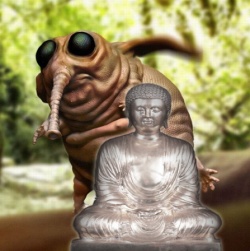True effect
true effect
本果妙 (Jpn honga-myo )
Also, the mystic principle of the true effect. The original enlightenment that Shakyamuni attained countless kalpas before his enlightenment in India. One of the ten mystic principles of the essential teaching (latter half) of the Lotus Sutra formulated by T'ient'ai (538-597) in The Profound Meaning of the Lotus Sutra. In contrast, the term "true cause" means the cause for that enlightenment. The true effect is indicated in the passage of the "Life Span" (sixteenth) chapter of the Lotus Sutra that reads, "Since I attained Buddhahood, an extremely long period of time has passed." In Profound Meaning, T'ient'ai states that, because the true cause leads to the true effect, he expounds the true cause first. In terms of Nichiren's (1222-1282) teaching, however, due to the simultaneity of cause and effect, both the true cause and the true effect are present together in one's life. In his treatise The Entity of the Mystic Law, Nichiren states: "When the sage was observing the principle... , he perceived that there is this wonderful single Law [[[myoho]] that simultaneously possesses both cause and effect renge, and he named it Myoho-renge. This single Law that is Myoho-renge encompasses within it all the phenomena comprising the Ten Worlds and the three thousand realms, and is lacking in none of them. Anyone who practices this Law will obtain both the cause and the effect of Buddhahood simultaneously" (421). Hence Nichiren is called the teacher of the true cause and the true effect.
